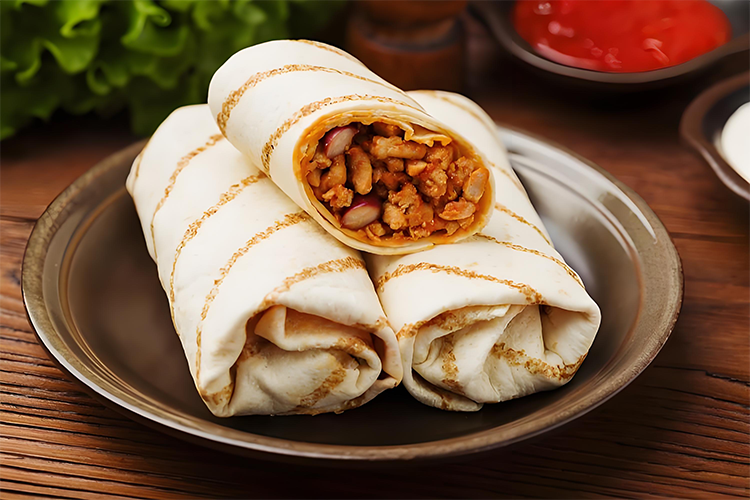Puyang Wrapped Liangpi (Henan cold skin): Refreshing Summer Street Snack to Try
1. Puyang Wrapped Liangpi: A Cool Summer Temptation
On the warm streets of Puyang in Henan province, a refreshingly simple street food draws locals and visitors alike: Puyang wrapped liangpi. Also called guo liangpi or rolled liangpi, this inventive take on cold skin noodles combines translucent sheets of liangpi with rich sauces and crunchy fillings, rolled into a portable snack. One bite delivers cool texture, nutty sesame, garlic heat, and a hint of chili — a perfect summer treat and an authentic taste of Central China.
2. Origins and Local Innovation
Liangpi itself traces back to northern China and is often associated with Shaanxi-style cold skin noodles. The rolled version seen in Puyang is a more recent local innovation that emerged from street vendors’ desire to make liangpi easier to eat on the go. By spreading sauces and layering crisp cucumber, crushed peanuts, wheat gluten cubes, and cilantro on a single sheet, vendors transformed a mixed salad into a tidy handheld roll. The result became a regional signature and a beloved city specialty.

3. Cultural Meaning: Practicality Meets Flavor
Puyang wrapped liangpi shows how Central Plain cuisine blends practicality with taste. It responds to fast-paced urban life: affordable, quickly made, and eaten while walking. The snack also reflects regional openness, merging the noodle tradition with cold, salad-like components. In neighborhoods across Puyang — near schools, markets, and evening snack streets — people gather at stalls, sharing conversation and a familiar comfort food that doubles as a social glue.
4. Key Ingredients: Freshness and Texture
A memorable wrapped liangpi depends on balanced ingredients. The liangpi sheets, often made from wheat or rice flour, are thin, slightly elastic, and translucent. Cucumber provides a crisp, hydrating contrast; roasted crushed peanuts add crunch and nuttiness; chewy wheat gluten (mianjin) soaks up sauce; and cilantro adds a bright herbal note. The sauce mix — typically sesame paste thinned with water, raw garlic, and fragrant chili oil — binds flavors together and gives the roll its distinctive personality.

5. Streetcraft: Fast, Skillful Assembly
Watching a skilled vendor prepare wrapped liangpi is part of the experience. A sheet of liangpi is laid flat, sauces are brushed with a practiced hand, then cucumber matchsticks, peanut crumbs, bits of wheat gluten, and cilantro are quickly arranged. With a deft roll, the vendor forms a tight cylinder and slips it into a paper or plastic bag for immediate eating. The whole process takes under a minute, showcasing speed honed by daily repetition.
6. Flavor Profile: A Layered Taste Experience
The taste of wrapped liangpi is layered and harmonious. The liangpi sheet provides a cool, slippery base, followed by cucumber’s refreshing crunch and peanut’s roasted sweetness. Mianjin adds chewiness while sesame paste brings creamy depth. Garlic offers sharpness and chili oil a warming finish. The combination delivers both cooling relief from heat and an appetite-stimulating, slightly spicy kick.

7. How to Eat and Tasting Tips
Wrapped liangpi is best eaten immediately after purchase, handheld like a sandwich. For first-time tasters, choosing medium spice helps appreciate the balance of sesame, garlic, and peanut without overwhelming the palate. Pair the roll with a chilled drink such as iced sour plum soda or mung bean tea to amplify the cooling effect. Because recipes vary by vendor, sampling several stalls is the best way to find a favorite version.
8. Where to Find the Most Authentic Rolls
Puyang has vendors across neighborhoods, but the most reliable spots tend to be near old town snack streets, university areas, and longstanding market lanes. Look for stalls with steady lines and vendors who prepare fillings fresh in front of you. Local favorites and time-honored stalls often keep secret sauce ratios that distinguish their rolls. Expect prices to be very affordable, making a food tour of multiple stalls an easy way to explore local variations.

9. Simple Home Recipe for Travelers
If you want to recreate wrapped liangpi away from Puyang, many Asian supermarkets sell liangpi sheets. Lay one sheet flat, mix sesame paste with water to a spreadable consistency, add a splash of garlic water and chili oil, then spread the sauce. Top with julienned cucumber, crushed roasted peanuts, small cubes of cooked wheat gluten or seitan, and chopped cilantro. Roll tightly, slice if desired, and enjoy immediately. Adjust spice and sesame ratios to suit your taste.
10. Final Note: A Must-Try Puyang Specialty
Puyang wrapped liangpi is more than a snack — it’s a compact expression of regional taste and street-food ingenuity. Its mix of cool texture, crunchy fillings, and flavorful sauces makes it especially satisfying on hot days. For travelers exploring Henan, seeking out a freshly made roll offers both a delicious bite and a deeper connection to local daily life. Let the wrapped liangpi be a flavorful memory from your Puyang visit.


